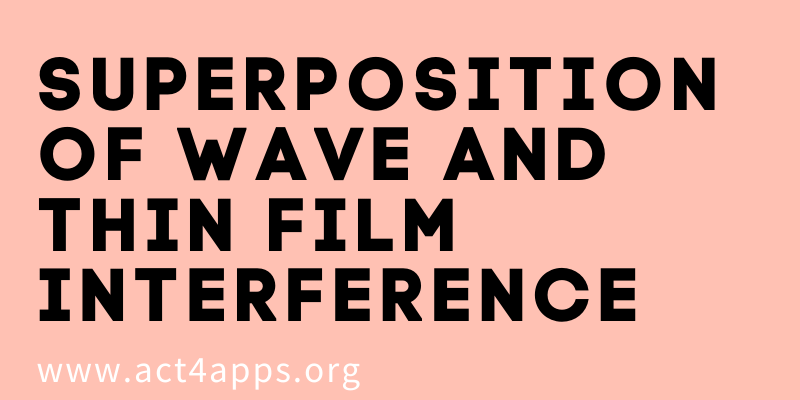
Superposition of Wave and Thin Film Interference
Principle of Superposition of Waves
Principle of Superposition of waves means the resultant displacement of all the waves in the medium at a particular point is the vector sum of the displacement of the individual waves.
Types of Superposition of Waves
Interference is the phenomenon where two or more waves superpose to form a resultant wave with an intensity higher or lower than the individual intensity values of the waves.
Based on the phase difference between the waves that superpose the waves are of two types
1.Constructive Interference
Constructive Interference occurs when the two waves that superpose are in the same phase. The resultant wave will have an amplitude which s equal to the sum of the amplitudes of the individual waves which results in maximum amplitudes of light.
2.Destructive Interference
Destructive Interference occurs when the two superimposing waves are out of phase. The amplitude of the resultant waves will be the difference in amplitude of the individual waves.
The intensity of the resultant wave will be minimum.
What is Thin Film Interference?
The Thin Film Interference occurs when the two light waves are reflected from two surfaces which are at a distance comparable to the wavelength of light. When the two light waves reflecting from the top surface and the bottom surface interfere with each other we get to see different colour patterns. The light rays reaching the boundary between two rays gets partially reflected and partially transmitted. If the two medium is air and thin film, then there are two reflections that occur on the top surface and lower surface of the thin film.
Condition for Thin Film Interference
The interference between the two reflected ray depends on the factors like the thickness of the thin film, the wavelength of the incident light, the angle at which light is incident and the refractive index of the medium. The source of light will be either be monochromatic or broadband. If the source of the light is monochromatic then the resultant interference pattern appears as light and dark bands. If the source of light is broadband then the interference pattern is colourful bands.
The refractive index of the medium determines the type of reflection the light will undergo. If the light reflects off a medium with lower refraction index then no phase shift will be observed. This is called soft reflection. If the light reflects off a medium with a higher reflection index then a phase shift of 180 degrees occurs.
Real-Life Examples of Thin Film Interference
Thin Film Interference is a common phenomenon that we encounter in our everyday life. The most common example is the colours on a soap bubble. In case of a soap bubble, the light waves that travel through the air hit the surface of the bubble and get reflected. Further, the rays that get transmitted reaches the lower film air interface and it gets reflected from the lower surface.
In this case, the refractive index of air is equal to 1 and the refractive index of the soap bubble is greater than 1. Therefore the light rays undergo a phase difference. In the lower surface of the soap bubble, there is no phase difference.






